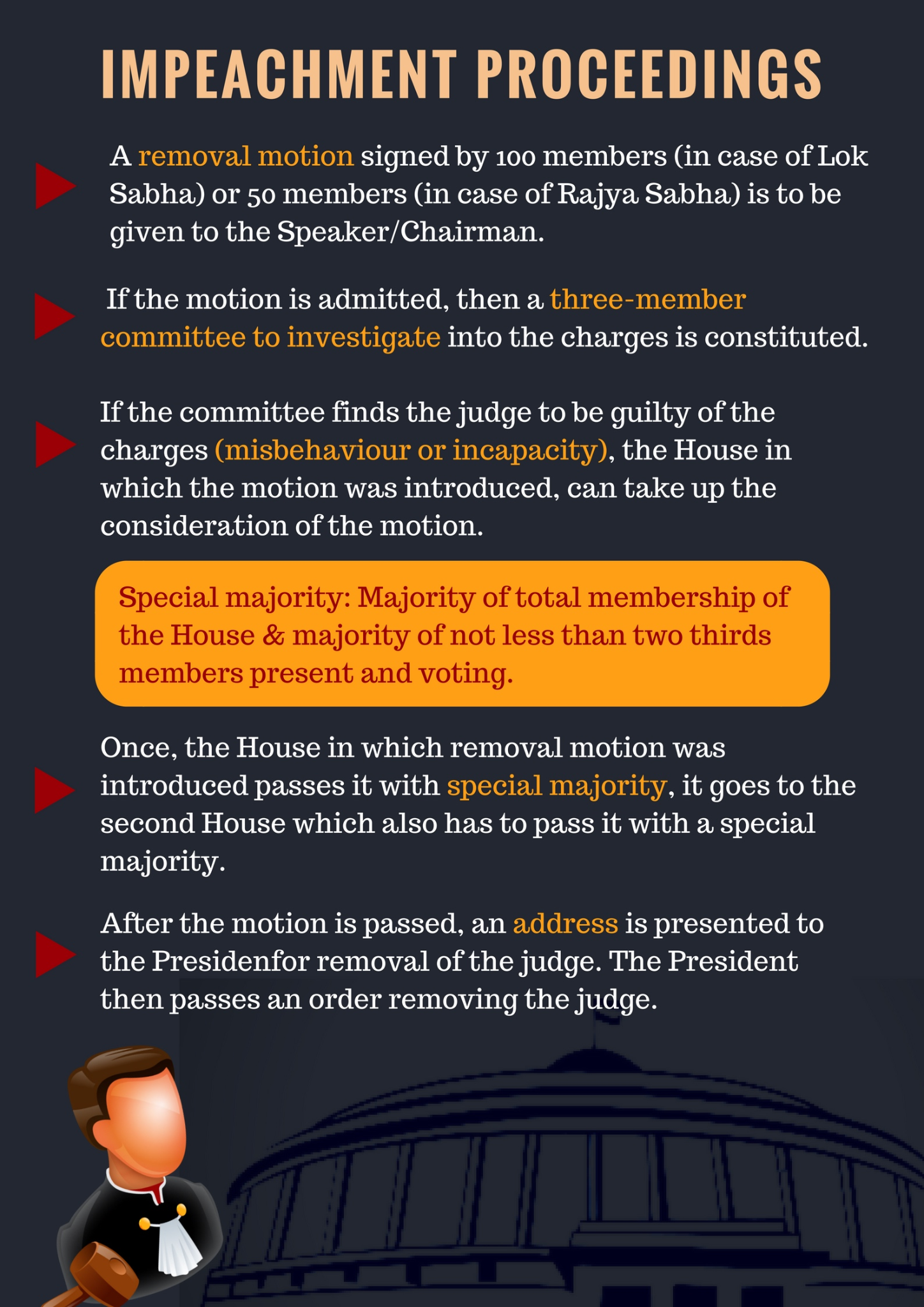Impeachment of Judges in India | 21 Jul 2025
Why in News?
Union Parliamentary Affairs Minister announced that over 100 Members of Parliament (MPs) have signed a notice to initiate an impeachment motion against Justice Yashwant Varma.
- The motion comes after a judicial panel indicted Justice Varma over sacks of burnt currency found at his residence during a fire in March 2025. Chief Justice Sanjeev Khanna recommended his removal, but Justice Varma refused to resign and instead challenged the findings in the Supreme Court of India.
What is the Impeachment Process for Judges in India?
- Judicial Impeachment: The word "impeachment" isn’t directly used in the Constitution of India for judges, it's the common term for the formal process to remove a judge of the Supreme Court or High Court for proved misbehaviour or incapacity.
- The process is meant to protect judicial integrity without allowing political interference.
- Constitutional and Legal Provisions: Articles 124(4) of the Constitution of India, along with the Judges (Inquiry) Act, 1968, provide the framework for removing judges of the Supreme Court. Article 218 extends these provisions to High Court judges.
- Judges can only be removed for Proved misbehaviour (serious ethical or professional misconduct) and incapacity (Inability to discharge duties due to physical or mental reasons).
- Impeachment Process:
- Initiating the Motion: An impeachment motion can be introduced in either the Lok Sabha or the Rajya Sabha. It must have the support of at least 100 MPs in the Lok Sabha or 50 MPs in the Rajya Sabha.
- The motion can proceed only if accepted by the Speaker or the Chairman.
- Inquiry Committee: A three-member committee is set up under the Judges (Inquiry) Act, 1968. It includes a Supreme Court judge (or the Chief Justice of India), the Chief Justice of a High Court, and an eminent jurist.
- The committee acts like a fact-finding body and holds a quasi-judicial inquiry into the charges.
- Committee Report and Parliamentary Debate: The committee submits its findings to the House that initiated the motion. If the judge is found guilty, the matter is debated in both Houses.
- Removal of a judge requires a special majority in both Houses of Parliament during the same session. This means the motion must be passed by an absolute majority (more than 50% of the total membership) and also by at least two-thirds of the members present and voting.
- Presidential Approval: The Constitution provides that based on a motion passed by both Houses of Parliament, a judge can be removed only by an order of the President.
- Initiating the Motion: An impeachment motion can be introduced in either the Lok Sabha or the Rajya Sabha. It must have the support of at least 100 MPs in the Lok Sabha or 50 MPs in the Rajya Sabha.
- Drawbacks of Impeachment Process for Judges in India: If a judge resigns during the proceedings, the process usually ends abruptly, raising questions about full accountability.
- No judge in India has been successfully impeached since independence. The stringent voting thresholds, along with political negotiations and shifting alliances, make the process rare and difficult to complete.
- Notable Impeachment Attempts in India
- Justice V. Ramaswami (1993): First SC judge to face impeachment. The panel found him guilty of misuse of funds, but motion failed in Lok Sabha due to abstentions.
- Justice Soumitra Sen (2011): Accused of misappropriating funds. Rajya Sabha passed the motion, but he resigned before it reached Lok Sabha.
UPSC Civil Services Examination, Previous Year Questions (PYQs)
Mains
Q1. Explain the reasons for the growth of public interest litigation in India. As a result, has the Indian Supreme Court emerged as the world's most powerful judiciary? (2024)
Q2. Discuss the desirability of greater representation to women in the higher judiciary to ensure diversity, equity and inclusiveness. (2021)

